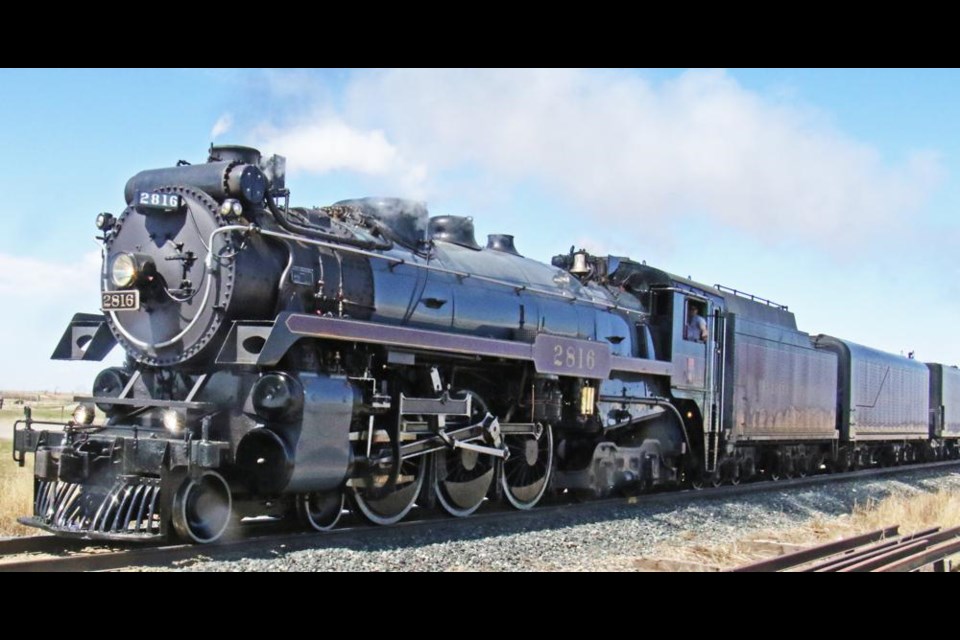WEYBURN – A large crowd gathered in the CP Rail yard in Weyburn on Monday morning to watch as a steam engine, No. 2816, built in 1930, pulled in to the city for a long stop as crews worked on it, before it set off on a journey that will take the engine down to Mexico City on the CPKC rail lines.
Dubbed the Final Spike Tour by the railway, it began on April 24 in Calgary, where the ceremonial “last spike” was driven in prior to the engine’s journey. There were scheduled stops in Moose Jaw on Sunday, and in Minot, N.D. on Tuesday, with the maintenance stop in Weyburn mid-morning on Monday. People gathered at nearly every rail crossing in the city’s area, on the side of Highway 39 and in the CP yard where the Holiday Train usually stops every December.
Once the train hits the U.S., the stops after Minot will include St. Paul, Minn.; Franklin Park, Ill.; Kansas City, Missouri; Shreveport, La., and Laredo, Texas, by May 28, before heading to Mexico City, to be put on display.
A unique group of railroaders committed to restoring Engine 2816, named The Empress, for a once-in-a-lifetime cross-continent trip that began in April 2024 to celebrate the one-year anniversary of CPKC.
According to CPKC’s website, the 4-6-4 Hudson-type steam locomotive No. 2816 was built in December 1930 by Montreal Locomotive Works. Originally intended for fast freight and passenger service, the locomotive worked primarily in Eastern Canada for nearly 30 years before retiring on May 26, 1960.
It served as a roving steam-powered ambassador for Canadian Pacific throughout Canada and the U.S. before being placed in storage in 2012. Now, after a decade of slumber, the engine has been carefully prepared to once again travel the rails.
As far as CPKC’s assets go, 2816 has proven its worth. It ran throughout the Great Depression, World War II and beyond, averaging at times up to 18,000 miles per month. In 30 years, it is estimated the locomotive ran over 3.5 million miles – far outrunning most diesel locomotives of the same age.
“These are very robust, overbuilt, heavy duty machines,” said Jonathan Morris, Manager Operating Practices - Steam, who led the restoration project. “It would leave Winnipeg, running at 100 miles an hour, and 850 miles later, it would arrive in Calgary where it would be turned, serviced, and sent east again. It would do this seven days a week.”
Unlike diesel locomotives, no two steam engines are the same. Each hand-built locomotive bears the markings of its makers: tons of steel and plumbing that begins as a product in the shop and transforms into a story on the rails, a synthesis of science and art.
Canadian Pacific (CP) wanted a title that conveyed elegance and nobility with a tie-in to CP's history. CP’s premier passenger liners were all titled "Empress", (Empress of Australia, Empress of Russia, Empress of Britain, etc.) and the call sign of CP Air Lines was also "Empress".
Steam engines evaporate 100 gallons of water each mile, and every reciprocating component weighs between 150 and 800 pounds – part of the reason they were phased out for more efficient and affordable diesel engines in the 1960s.
Vital Statistics about The Empress
- Locomotive Number: 2816
- Class: H1b
- Builder: Montreal Locomotive Works
- Date built: December, 1930
- Last revenue run: May 26, 1960
- Type: Hudson
- Wheel arrangement: 4 – 6- 4
- Tractive effort: 45,300 lb (20,548 kg)
- Driving wheel diameter: 75 in (190.5 cm)
- Total operating weight (including tender): 643,000 lb (291,665 kg)
- Extreme length (including tender): 91 ft 2 in (27.8 metres)
- Extreme height: 15 ft 3 in (4.6 metres)
- Original cost: $116,555
- Converted from coal to oil: March, 1999



